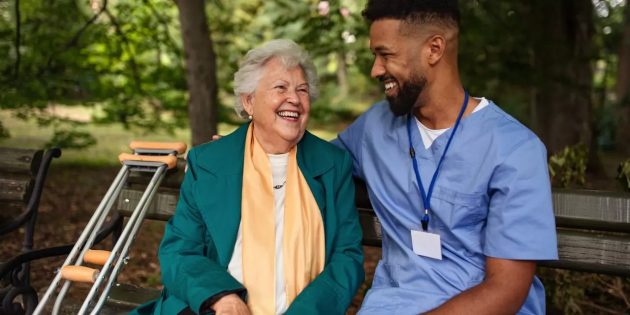
By Mia Haney
Navigating the healthcare landscape in 2022 has become increasingly difficult. Healthcare no longer begins and ends in an ambulatory care facility or at a hospital. The healthcare continuum extends outside into the “real world.” All around us, non-clinical factors affect our health outcomes, and medical staff aren’t the only people who can impact them.
For those on Medicare and Medicaid who live independently, caregivers provide a different kind of support. Instead of giving shots and performing tests, they help with activities of daily living (ADL), such as cooking, cleaning, errands and bathing. These services—while not inherently medical—can help patients’ health in other ways.
While many believe home care’s primary role is to help provide basic necessities to those living independently, home care (also known as personal care), plays a bigger part in the healthcare continuum. Without the help of a caregiver, many patients may experience negative health outcomes outside of the adverse effects of not fulfilling their day-to-day needs.
Whole person health relies on getting a big-picture view of a person’s healthcare needs. Personal care can help achieve that.
The home care landscape
As of 2010, 12 million Americans receive care at home, and that number has likely increased since then due to the growth and aging of the U.S. population. This is also due, in large part, to many Americans’ desire to stay at home as they age. Nearly 80% of adults aged 50 and older say they want to live independently in their home and community as they age.
For individuals with disabilities, living independently in their home and community is a priority as well. A majority of people with intellectual and/or developmental disabilities (I/DD) said they would prefer to reside in their own house or apartment within their community, according to a recent survey by The Arc.
To find success in living independently, many older adults and people with disabilities need help with ADL. In fact, one in five U.S. adults report receiving ADL assistance, according to Kaiser Family Foundation. Without this assistance, many people would need to rely on a family member or friend to help with daily tasks, and there is mounting evidence that personal care is becoming increasingly difficult for unpaid caregivers to manage.
It's understood in healthcare that if people’s basic needs aren’t met, independently or through the help of a caregiver, their health can suffer tremendously. This encompasses more than physical health, which is maintained through things like eating healthy food, getting enough sleep and remembering to take necessary medications. If one can’t properly bathe themselves or keep a clean living area, for instance, mental and emotional health can suffer as a result.
Personal care’s place in the healthcare continuum stretches even further, however. A caregiver’s impact in the lives of those they serve may go beyond simply supporting their health. Aides don’t just help them survive—they can help them thrive.
Benefits of staying home
The assistance caregivers provide can help people successfully live at home long term, help them achieve a greater sense of independence and fulfillment and encourage positive health outcomes. Staying at home with the assistance of a caregiver can have numerous health benefits, including helping to:
In addition to the health benefits that living independently with a caregiver’s help can help provide, there are also monetary advantages. Studies show that when older adults live at home, cost savings happens for multiple parties:
Research also reveals that living in the community is more cost-effective for individuals with I/DD.
While direct health and monetary benefits certainly have an impact on health outcomes, other, more complex factors may come into play that have an indirect effect.
Social determinants of health in the home
To maintain continuity of care for older adults and individuals with disabilities living at home, healthcare professionals must examine not only medical aspects of health but also the “non-medical factors that influence health outcomes,” or social determinants of health (SDoH), as defined by the World Health Organization.
Although clinical home care workers—who vary from caregivers in that they have medical training—may perform more formal SDoH evaluations, caregivers can informally assess their client’s environment for SDoH factors. This is a needed service, as only approximately 24% of hospitals and 16% of physician practices reported screening for these factors in 2019.
As most caregivers are a consistent part of their client’s life, they can be the eyes and ears in the patient’s home for any non-medical or environmental factors that may affect the patient’s health. They can help identify, notate and potentially assist in mitigating SDoH challenges, such as housing instability, transportation needs, food insecurity and other issues that may indicate potential causes of poor patient health. They can do more than cook their meals and clean their house, they can also point out signs of poor nutrition, food insecurity or an unstable living environment—all important facets to improve health.
Putting the pieces together, it becomes clear that personal care is an integral part of the healthcare continuum. For some of our most vulnerable patients—older Americans and individuals with disabilities—receiving ongoing care outside of a clinical setting is critical to experiencing positive health outcomes. This includes identifying and addressing SDoH factors such as transportation and food insecurity. Caregivers are the crucial link between the patient and the healthcare they need.
Mia Haney is Chief Operating Officer – Personal Care at Modivcare.
SHARE
Subscribe to receive our latest blog articles delivered straight to your inbox.
RESOURCES